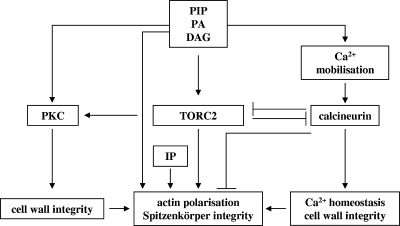FIG. 8.
A reconstructed model for polarity control and apical branching in A. niger. The model rests on transcriptomic and phenotypic data obtained from ramosa-1 mutant and wild-type A. niger (this work and references 77 and 78), as well as on assumptions deduced from conserved mechanisms in yeast and mammalian systems (see Discussion for references). Basically, TORC2 exerts at least three important cellular functions. (i) TORC2 plays a crucial role in maintaining actin polarization, among other things, via calcineurin inhibition. (ii) TORC2 is essential for cell wall biosynthesis and activates PKC, the initiator kinase of the CWI pathway. (iii) TORC2 inhibits expression of oxidative stress genes under nonstressed conditions (not indicated in the figure). RmsAY447N, however, negatively interferes with A. niger TORC2 function, resulting in actin depolarization, induction of apical branch formation, and derepression of oxidative stress genes. To counteract failure of TORC2, increased synthesis of important (phospho)lipid signaling molecules takes place (reactions 1 to 6) (Table 3 and Fig. 7), resulting in (i) increased Rom2p/Rho1p activation (via PIP2) aiming to repolarize actin, (ii) reactivation of TORC2 (via PIP2), (iii) reinforced PKC activation (via DAG) and thereby amplified expression of cell wall-related genes, and (iv) repolarization of actin (via IP7).

